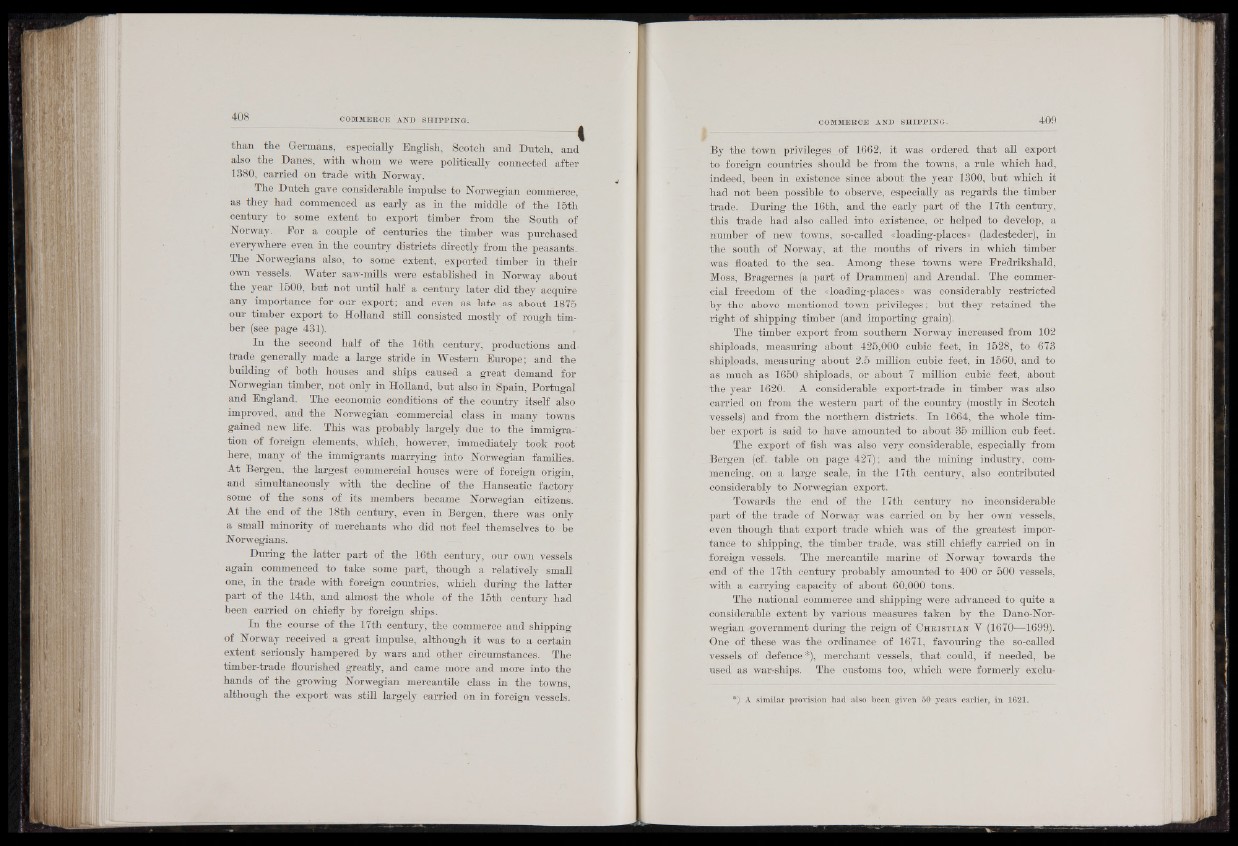
4 0 8 COMMERCE AND SH IP P IN G .
------------------------------------------------------------------------------------- ■------------------------------------------------------------------------------------------------ - ~ — ~ i
than the Germans, especially English, Scotch and Dutch, and
also the Danes, with whom we were politically connected after
1380, carried on trade with Norway.
The Dntch gave considerable impulse to Norwegian commerce,
as they had commenced as early as in the middle of the 15th
century to some extent to export timber from the South of
Norway. Eor a couple of centuries the timber was purchased
everywhere even in the country districts directly from the peasants.
The Norwegians also, to some extent, exported timber in their
own vessels. Water saw-mills were established in Norway about
the year 1500, but not until half a century later did they acquire
any importance for our export; and even as late as about 1875
our timber export to Holland still consisted mostly of rough timber
(see page 431).
In the second half of the 16th century, productions and-
trade generally made a large stride in Western Europe; and the
building of both houses and ships caused a great demand for
Norwegian timber, not only in Holland, but also in Spain, Portugal
and England. The economic conditions of the country itself also
improved, and the Norwegian commercial class in many towns
gained new life. This was probably largely due to the immigration
of foreign elements, which, however, immediately took root
here, many of the immigrants marrying into Norwegian families.
At Bergen, the largest commercial houses were of foreign, origin,
and simultaneously with the decline of the Hanseatic factory
some of the sons of its members became Norwegian citizens.
At the end of the 18th century, even in Bergen, there was only
a small minority of merchants who did not feel themselves to be
Norwegians.
During the latter part of the 16th century, our own vessels
again commenced to take some part, though a relatively small
one, in the trade with foreign countries, which during the latter
part of the 14th, and almost the whole of the 15th century had
been carried on chiefly by foreign ships.
In the course of the 17th century, the commerce and shipping
of Norway received a great impulse, although it was to a certain
extent seriously hampered by wars and other circumstances. The
timber-trade flourished greatly, and came more and more into the
hands of the growing Norwegian mercantile class in the towns,
although the export was still largely carried on in foreign vessels.
By the town privileges of 1662, it was ordered that all export
to foreign countries should be from the towns, a rule which had,
indeed, been in existence since about the year 1300, but which it
had not been possible to observe, especially as regards the timber
trade. During the 16th, and the early part of the 17th century,
this trade had also called into existence, or helped to develop, a
number of new towns, so-called «loading-places» (ladestederj, in
the south of Norway, at the mouths of rivers in which timber
was floated to the sea. Among these towns were Eredrikshald,
Moss, Bragernes (a part of Drammen) and Arendal. The commercial
freedom of the «loading-places» was considerably restricted
by the above mentioned town privileges; but they retained the
right of shipping timber (and importing grain).
The timber export from southern Norway increased from 102
shiploads, measuring about 425,000 cubic feet, in 1528, to 673
shiploads, measuring about 2.5 million cubic feet, in 1560, and to
as much as 1650 shiploads, or about 7 million cubic feet, about
the year 1620. A considerable export-trade in timber was also
carried on from the western part of the country (mostly in Scotch
vessels) and from the northern districts. In 1664, the whole timber
export is said to have amounted to about 35 million cub feet.
The export of fish was also very considerable, especially from
Bergen (cf. table on page 427); and the mining industry, commencing,
on a large scale, in the 17th century, also contributed
considerably to Norwegian export.
Towards the end of the 17th century no inconsiderable
part of the trade of Norway was carried on by her own vessels,
even though that export trade which was of the greatest importance
to shipping, the timber trade, was still chiefly carried on in
foreign vessels. The mercantile marine of Norway towards the
end of the 17th century probably amounted to 400 or 500 vessels,
with a carrying capacity of about 60,000 tons.
The national commerce and shipping were advanced to quite a
considerable extent by various measures taken by the Dano-Nor-
wegian government during the reign of C h r i s t i a n Y (1670—1699.).
One of these was the ordinance of 1671, favouring the so-called
vessels of defence*), merchant vessels, that could, if needed, be
used as war-ships. The customs too, which were formerly exclu-
*) A similar provision had also been given 50 years earlier, in 1621.